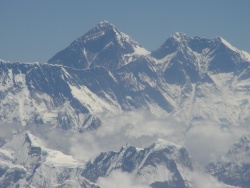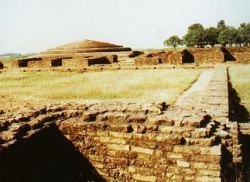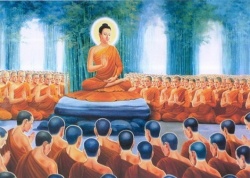Difference between revisions of "Vatsiputriya"
m (Text replacement - "reign" to "reign") |
|||
| (4 intermediate revisions by one other user not shown) | |||
| Line 1: | Line 1: | ||
[[File:Himalayas9.JPG|thumb|250px|]] | [[File:Himalayas9.JPG|thumb|250px|]] | ||
<poem> | <poem> | ||
| − | [[Vatsiputriya]] | + | [[Vatsiputriya school]] |
[[犢子部]] (Skt; Jpn [[Tokushi-bu]]) | [[犢子部]] (Skt; Jpn [[Tokushi-bu]]) | ||
| Line 13: | Line 13: | ||
[[Shannagarika]] schools. | [[Shannagarika]] schools. | ||
| + | |||
[[File:Kapilavastu.jpg|thumb|250px|]] | [[File:Kapilavastu.jpg|thumb|250px|]] | ||
| − | [[Vatsiputriya]] ([[Wyl.]] [[gnas ma bu pa'i sde]]) - a branch of the [[Sammitiya]] school of the [[basic vehicle]], whose followers asserted the [[existence]] of an '[[inexpressible self]]' ([[brjod du med pa'i bdag]]), which can not be said to be either the same as, or {{Wiki|distinct}} from, the [[five aggregates]], or as either [[permanent]] or [[impermanent]], and so on. This [[assertion]] was refuted by other schools, and by [[Dignaga]], who was once a follower of this [[tradition]] under a [[teacher]] called [[Nagadatta]]. One on occasion, the young [[Dignaga]] sat [[meditating]] in his room, naked, and surrounded by lots of lamps. When the [[teacher]] came in and asked him what he was doing, he said: “[[Teacher]], you told us there is an inexpressible [[self]] within our [[bodies]], so I am looking for it!” Then the [[teacher]] [[realized]] he was [[being]] mocked, so he expelled the [[student]], who, of couse, went on to become one of the most famous [[scholars]] in all of [[India]]. | + | [[Vatsiputriya]] ([[Wyl.]] [[gnas ma bu pa'i sde]]) - a branch of the [[Sammitiya]] school of the [[basic vehicle]], whose followers asserted the [[existence]] of an '[[inexpressible self]]' ([[brjod du med pa'i bdag]]), which can not be said to be either the same as, or {{Wiki|distinct}} from, the [[five aggregates]], or as either [[permanent]] or [[impermanent]], and so on. This [[assertion]] was refuted by other schools, and by [[Dignaga]], who was once a follower of this [[tradition]] under a [[teacher]] called [[Nagadatta]]. |
| + | |||
| + | One on [[occasion]], the young [[Dignaga]] sat [[meditating]] in his room, naked, and surrounded by lots of lamps. When the [[teacher]] came in and asked him what he was doing, he said: “[[Teacher]], you told us there is an inexpressible [[self]] within our [[bodies]], so I am looking for it!” Then the [[teacher]] [[realized]] he was [[being]] mocked, so he expelled the [[student]], who, of couse, went on to become one of the most famous [[scholars]] in all of [[India]]. | ||
00 years after the [[parinibbana]] of the [[Buddha]] (~286 B.C.) an elder called [[Vatsiputra]] prepared a new recession of the [[Abhidhamma]] in 9 [[sections]] which he claimed to have received from [[Sariputra]] and [[Rahula]]. The [[Sthaviravada]] school divided over the question whether this {{Wiki|concept}}, the "[[person]]" should be considered as a real [[principle]] among those listed in the [[Abhidhamma]] or whether it is merely a [[word]] used in [[Wikipedia:Convention (norm)|conventional]] [[language]], like "[[self]]' or "[[soul]]" or "[[being]]". [[Vatsiputra]] later formulated his special [[doctrine]] about the "[[person]]" ([[pudgala]]). The followers were called the [[Vatsiputriyas]] after [[Vatsiputra]]. | 00 years after the [[parinibbana]] of the [[Buddha]] (~286 B.C.) an elder called [[Vatsiputra]] prepared a new recession of the [[Abhidhamma]] in 9 [[sections]] which he claimed to have received from [[Sariputra]] and [[Rahula]]. The [[Sthaviravada]] school divided over the question whether this {{Wiki|concept}}, the "[[person]]" should be considered as a real [[principle]] among those listed in the [[Abhidhamma]] or whether it is merely a [[word]] used in [[Wikipedia:Convention (norm)|conventional]] [[language]], like "[[self]]' or "[[soul]]" or "[[being]]". [[Vatsiputra]] later formulated his special [[doctrine]] about the "[[person]]" ([[pudgala]]). The followers were called the [[Vatsiputriyas]] after [[Vatsiputra]]. | ||
| Line 20: | Line 23: | ||
According to [[Abhidhamma]], the [[Buddha]] uses the [[word]] in some of his [[discourses]] as he uses "[[being]]" in others. The question was whether He was just using everyday [[language]] in {{Wiki|speaking}} to hearers who would not understand a [[philosophical]] statement or whether he assumed any sort of [[reality]] apart from the groups [[senses]] and [[mental]] {{Wiki|principles}} counted in the [[Abhidhamma]]. The [[Vatsiputriyas]] advocated the {{Wiki|theory}} of the '[[pudgala]]', the [[permanent]] [[substance]] of an {{Wiki|individual}}. The [[pudgala]] was neither the same as nor different from the [[skandhas]]. Like the [[Sarvastivadins]], they believed that an [[arhat]] could fall and that {{Wiki|heretics}} could also attain miraculous [[powers]]. They also believed in [[antara-bhava]]. | According to [[Abhidhamma]], the [[Buddha]] uses the [[word]] in some of his [[discourses]] as he uses "[[being]]" in others. The question was whether He was just using everyday [[language]] in {{Wiki|speaking}} to hearers who would not understand a [[philosophical]] statement or whether he assumed any sort of [[reality]] apart from the groups [[senses]] and [[mental]] {{Wiki|principles}} counted in the [[Abhidhamma]]. The [[Vatsiputriyas]] advocated the {{Wiki|theory}} of the '[[pudgala]]', the [[permanent]] [[substance]] of an {{Wiki|individual}}. The [[pudgala]] was neither the same as nor different from the [[skandhas]]. Like the [[Sarvastivadins]], they believed that an [[arhat]] could fall and that {{Wiki|heretics}} could also attain miraculous [[powers]]. They also believed in [[antara-bhava]]. | ||
[[File:Himalayas36.jpg|thumb|250px|]] | [[File:Himalayas36.jpg|thumb|250px|]] | ||
| + | |||
Like all [[Buddhists]] the [[Vatsiputriyas]] rejected the {{Wiki|Brahmanical}} {{Wiki|concept}} of an [[eternal]] [[soul]], on the other hand, they rejected the {{Wiki|orthodox}} [[Sthaviravada]] {{Wiki|theory}} (which is also that of all other schools of [[Buddhism]]) that a [[living being]] is [[nothing]] but the five groups with the [[senses]]. However they found it difficult to define what a "[[person]]" could be, as a [[subject]] which continued and {{Wiki|transmigrated}}. They in fact decided that it could not be said what it was, like the [[undetermined]] questions to which there was no answer. | Like all [[Buddhists]] the [[Vatsiputriyas]] rejected the {{Wiki|Brahmanical}} {{Wiki|concept}} of an [[eternal]] [[soul]], on the other hand, they rejected the {{Wiki|orthodox}} [[Sthaviravada]] {{Wiki|theory}} (which is also that of all other schools of [[Buddhism]]) that a [[living being]] is [[nothing]] but the five groups with the [[senses]]. However they found it difficult to define what a "[[person]]" could be, as a [[subject]] which continued and {{Wiki|transmigrated}}. They in fact decided that it could not be said what it was, like the [[undetermined]] questions to which there was no answer. | ||
| + | |||
The original [[Vatsiputriyas]] seem to have remained in the [[East]], settling in [[Kosala]], [[Varanasi]] and [[being]] (as were the [[Sammitiyas]]) one of the [[early schools]] which still flourished in the homeland of [[Buddhism]] in the [[time]] of the {{Wiki|Pala Empire}} (8 - 12th centuries A.D.). | The original [[Vatsiputriyas]] seem to have remained in the [[East]], settling in [[Kosala]], [[Varanasi]] and [[being]] (as were the [[Sammitiyas]]) one of the [[early schools]] which still flourished in the homeland of [[Buddhism]] in the [[time]] of the {{Wiki|Pala Empire}} (8 - 12th centuries A.D.). | ||
[[File:Zusammenkunft.jpg|thumb|250px|]] | [[File:Zusammenkunft.jpg|thumb|250px|]] | ||
| + | |||
After [[Vatsiputra]] had given his school the [[Abhidhamma]] in nine [[sections]], his followers set to develop this further by studying the [[Sutra]]. The result of these studies was the production of no less than 4 [[new schools]]. In later centuries, the main centers of these schools seem to have been in {{Wiki|Western}} {{Wiki|Maharastra}}, {{Wiki|Gujarat}} and [[Sindhu]]. The only treatise that is now [[existing]] is the {{Wiki|Chinese}} translation of the [[Asrayaprajnaptisastra]] (or [[Sammitiyasastra]]), no other texts of any of these [[four schools]] or of the [[Vatsiputriya]] itself appears to have survived. The [[four schools]] were: | After [[Vatsiputra]] had given his school the [[Abhidhamma]] in nine [[sections]], his followers set to develop this further by studying the [[Sutra]]. The result of these studies was the production of no less than 4 [[new schools]]. In later centuries, the main centers of these schools seem to have been in {{Wiki|Western}} {{Wiki|Maharastra}}, {{Wiki|Gujarat}} and [[Sindhu]]. The only treatise that is now [[existing]] is the {{Wiki|Chinese}} translation of the [[Asrayaprajnaptisastra]] (or [[Sammitiyasastra]]), no other texts of any of these [[four schools]] or of the [[Vatsiputriya]] itself appears to have survived. The [[four schools]] were: | ||
| − | |||
| − | (b) [[Bhadrayaniya]] : are found on the edge of the Maharastrian plateau ([[Nasika]]), behind the [[Dharmottariyas]], but each had at least one [[vihara]] in the other territory. | + | (a) [[Dharmottariya]] : are found in [[Aparanta]] on the coast of {{Wiki|Maharastra}} (at the port of [[Surparaka]], the capital of the [[Aparanta]] country proper and places nearby). |
| + | |||
| + | (b) [[Bhadrayaniya]] : are found on the edge of the [[Maharastrian]] plateau ([[Nasika]]), behind the [[Dharmottariyas]], but each had at least one [[vihara]] in the other territory. | ||
| + | |||
| + | (c) [[Sammitiya]] : According to [[Vasumitra]] this school originated in the 3rd century B.C. after the [[parinibbana]] of the [[Buddha]]. Because it branched off from the [[Vatsiputriyas]] therefore was sometimes called the [[Vatsiputriya Sammitiyas]]. | ||
| + | |||
| − | + | [[Sammitiyas]] was much more widespread and vigorous school among the four, who spread across [[Avanti]] and {{Wiki|Gujarat}} to [[form]] their main center in [[Sindhu]] though they also maintained themselves in the [[East]]. This school gradually [[attained]] importance in Northern [[India]] during the [[Gupta]] period reaching climax in the reign of [[Harsavardhana]]. It is very probable that this school had a [[pitaka]] of their [[own]] handed down orally from generation to generation and then written down when they flourished in the [[Gupta]] period using [[Apabhramsa]] - the {{Wiki|dialect]] prevalent in the place. They are predominant in Malwa, Sind and other neighbouring places. | |
| − | |||
The only remarkable [[doctrine]] of the [[Sammitiyas]] is that regarding the nature of the [[pudgala]]. They admitted the [[impermanence]] of material composites but at the same time held the [[view]] that there was an entity which should be distinguished from the 5 [[skandhas]] that meanwhile could not [[exist]] independently of those [[skandhas]]. It served as the carrier of the 5 [[skandhas]] through [[births]] and [[rebirths]] of [[beings]] as they held that there is an [[antarabhava]] i.e. an intermediate state between the [[death]] of a [[being]] and its [[rebirth]]. They also agreed with the [[Sarvastivadins]] and the [[Mahasanghikas]] in [[holding]] that the stage of an [[arahat]] is not immune from a fall to a lower stage and that [[spiritual]] progress is always gradual. | The only remarkable [[doctrine]] of the [[Sammitiyas]] is that regarding the nature of the [[pudgala]]. They admitted the [[impermanence]] of material composites but at the same time held the [[view]] that there was an entity which should be distinguished from the 5 [[skandhas]] that meanwhile could not [[exist]] independently of those [[skandhas]]. It served as the carrier of the 5 [[skandhas]] through [[births]] and [[rebirths]] of [[beings]] as they held that there is an [[antarabhava]] i.e. an intermediate state between the [[death]] of a [[being]] and its [[rebirth]]. They also agreed with the [[Sarvastivadins]] and the [[Mahasanghikas]] in [[holding]] that the stage of an [[arahat]] is not immune from a fall to a lower stage and that [[spiritual]] progress is always gradual. | ||
Latest revision as of 04:00, 21 November 2015
Vatsiputriya school
犢子部 (Skt; Jpn Tokushi-bu)
One of the twenty Hinayana schools. The Vatsiputriya school broke away from the Sarvastivada school and advocated a view of the existence of the self as a separate entity. Later the Vatsiputriya school split into four—the:
Dharmottara,
Bhadrayaniya,
Sammatiya, and
Shannagarika schools.
Vatsiputriya (Wyl. gnas ma bu pa'i sde) - a branch of the Sammitiya school of the basic vehicle, whose followers asserted the existence of an 'inexpressible self' (brjod du med pa'i bdag), which can not be said to be either the same as, or distinct from, the five aggregates, or as either permanent or impermanent, and so on. This assertion was refuted by other schools, and by Dignaga, who was once a follower of this tradition under a teacher called Nagadatta.
One on occasion, the young Dignaga sat meditating in his room, naked, and surrounded by lots of lamps. When the teacher came in and asked him what he was doing, he said: “Teacher, you told us there is an inexpressible self within our bodies, so I am looking for it!” Then the teacher realized he was being mocked, so he expelled the student, who, of couse, went on to become one of the most famous scholars in all of India.
00 years after the parinibbana of the Buddha (~286 B.C.) an elder called Vatsiputra prepared a new recession of the Abhidhamma in 9 sections which he claimed to have received from Sariputra and Rahula. The Sthaviravada school divided over the question whether this concept, the "person" should be considered as a real principle among those listed in the Abhidhamma or whether it is merely a word used in conventional language, like "self' or "soul" or "being". Vatsiputra later formulated his special doctrine about the "person" (pudgala). The followers were called the Vatsiputriyas after Vatsiputra.
According to Abhidhamma, the Buddha uses the word in some of his discourses as he uses "being" in others. The question was whether He was just using everyday language in speaking to hearers who would not understand a philosophical statement or whether he assumed any sort of reality apart from the groups senses and mental principles counted in the Abhidhamma. The Vatsiputriyas advocated the theory of the 'pudgala', the permanent substance of an individual. The pudgala was neither the same as nor different from the skandhas. Like the Sarvastivadins, they believed that an arhat could fall and that heretics could also attain miraculous powers. They also believed in antara-bhava.
Like all Buddhists the Vatsiputriyas rejected the Brahmanical concept of an eternal soul, on the other hand, they rejected the orthodox Sthaviravada theory (which is also that of all other schools of Buddhism) that a living being is nothing but the five groups with the senses. However they found it difficult to define what a "person" could be, as a subject which continued and transmigrated. They in fact decided that it could not be said what it was, like the undetermined questions to which there was no answer.
The original Vatsiputriyas seem to have remained in the East, settling in Kosala, Varanasi and being (as were the Sammitiyas) one of the early schools which still flourished in the homeland of Buddhism in the time of the Pala Empire (8 - 12th centuries A.D.).
After Vatsiputra had given his school the Abhidhamma in nine sections, his followers set to develop this further by studying the Sutra. The result of these studies was the production of no less than 4 new schools. In later centuries, the main centers of these schools seem to have been in Western Maharastra, Gujarat and Sindhu. The only treatise that is now existing is the Chinese translation of the Asrayaprajnaptisastra (or Sammitiyasastra), no other texts of any of these four schools or of the Vatsiputriya itself appears to have survived. The four schools were:
(a) Dharmottariya : are found in Aparanta on the coast of Maharastra (at the port of Surparaka, the capital of the Aparanta country proper and places nearby).
(b) Bhadrayaniya : are found on the edge of the Maharastrian plateau (Nasika), behind the Dharmottariyas, but each had at least one vihara in the other territory.
(c) Sammitiya : According to Vasumitra this school originated in the 3rd century B.C. after the parinibbana of the Buddha. Because it branched off from the Vatsiputriyas therefore was sometimes called the Vatsiputriya Sammitiyas.
Sammitiyas was much more widespread and vigorous school among the four, who spread across Avanti and Gujarat to form their main center in Sindhu though they also maintained themselves in the East. This school gradually attained importance in Northern India during the Gupta period reaching climax in the reign of Harsavardhana. It is very probable that this school had a pitaka of their own handed down orally from generation to generation and then written down when they flourished in the Gupta period using Apabhramsa - the {{Wiki|dialect]] prevalent in the place. They are predominant in Malwa, Sind and other neighbouring places.
The only remarkable doctrine of the Sammitiyas is that regarding the nature of the pudgala. They admitted the impermanence of material composites but at the same time held the view that there was an entity which should be distinguished from the 5 skandhas that meanwhile could not exist independently of those skandhas. It served as the carrier of the 5 skandhas through births and rebirths of beings as they held that there is an antarabhava i.e. an intermediate state between the death of a being and its rebirth. They also agreed with the Sarvastivadins and the Mahasanghikas in holding that the stage of an arahat is not immune from a fall to a lower stage and that spiritual progress is always gradual.



